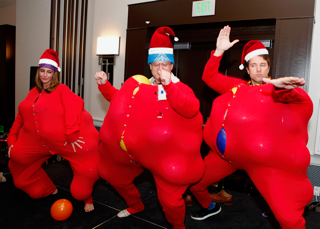Team building events are a great way to get your department out of their comfort zones and into a creative space. But are there any common pitfalls you should avoid when planning your event? Yes! We’ve listed a few team building mistakes we see companies making below:
Lose the Corporate Culture
We’ve all attended those team building events that were so saturated in corporate culture, they sucked the fun out of the day.
Team building is supposed to be fun. A lot of companies forget that. They’re so worried that they’re not going to see a return on their investment that they forget to let their employees have fun which is actually crucial to any level of engagement.
You have approximately 260 workdays to instill company culture in your employees. There are great opportunities to incorporate corporate goals and identity into a team building event, but don’t don’t push it at the expense of a productive day of fun!
Know Your Audience
Don’t schedule a physically challenging event if your employees clearly have never strapped on a belay harness or picked up a kayak paddle. While some of your employees might love the challenge, the ones who aren’t comfortable with intense physical activity will feel like outliers.
On the flip side, if you have a smaller group whose individuals all share some unique capabilities or interests (e.g. hiking), that’s a great starting point.
As a general rule though, it’s better to err on the side of inclusivity. Keep in mind that some colleagues may not feel comfortable sharing their limitations for fear of putting a damper on the group’s ideas.
DIY Team Building: Proceed with Caution
As a team building company ourselves, we obviously bring our own biases here. In fact, DIY team building events can be awesome if they’re done right. However, pulling off an internally-organized event can be difficult without appropriate resources and experience.
Companies often choose to DIY in the hopes of keeping their budget low, only to find out that the resources involved in planning and logistics are far more significant than anticipated. This is particularly true of planning offsite events.
Ultimately, if you have an enthusiastic individual or team that can dedicate themselves to planning and coordinating, then DIY can be a great way to go. If not, hiring a team building facilitator with specialized staff and experience allows you to participate in the most important part: having fun with your team.
Don’t Lose Sight of Your Goal
Why have you decided to schedule a team building event? Is it to help new members bond with the other members of your team? Do you want to harness your team’s creative potential? Do you want individual members to start working more as a team and less like individuals?
Having some clear goals and priorities can help your organizer to structure the event in a more effective way. Group size, location, and team challenges are all factors that can be designed in a way to best meet these goals.
Failing to Follow-Up Is a Waste of an Outing
What happens after the event is over? How do you maintain all that high-five energy and enthusiasm your team found the day of the event?
Identify where the team building event was a success in meeting your goals and create opportunities to recall and build on the experience – small follow ups go a long way (e.g. lunch with the group you competed with in the event).
The best way to follow up with your team is to create a visual reminder of the day. Write key takeaways on a whiteboard. Hang photos of the day’s highlights in the break room. These small things help to keep the out-of-the-box mindset that was fostered during the event fresh and relevant to daily routines, which is really the ultimate goal of team building.





























